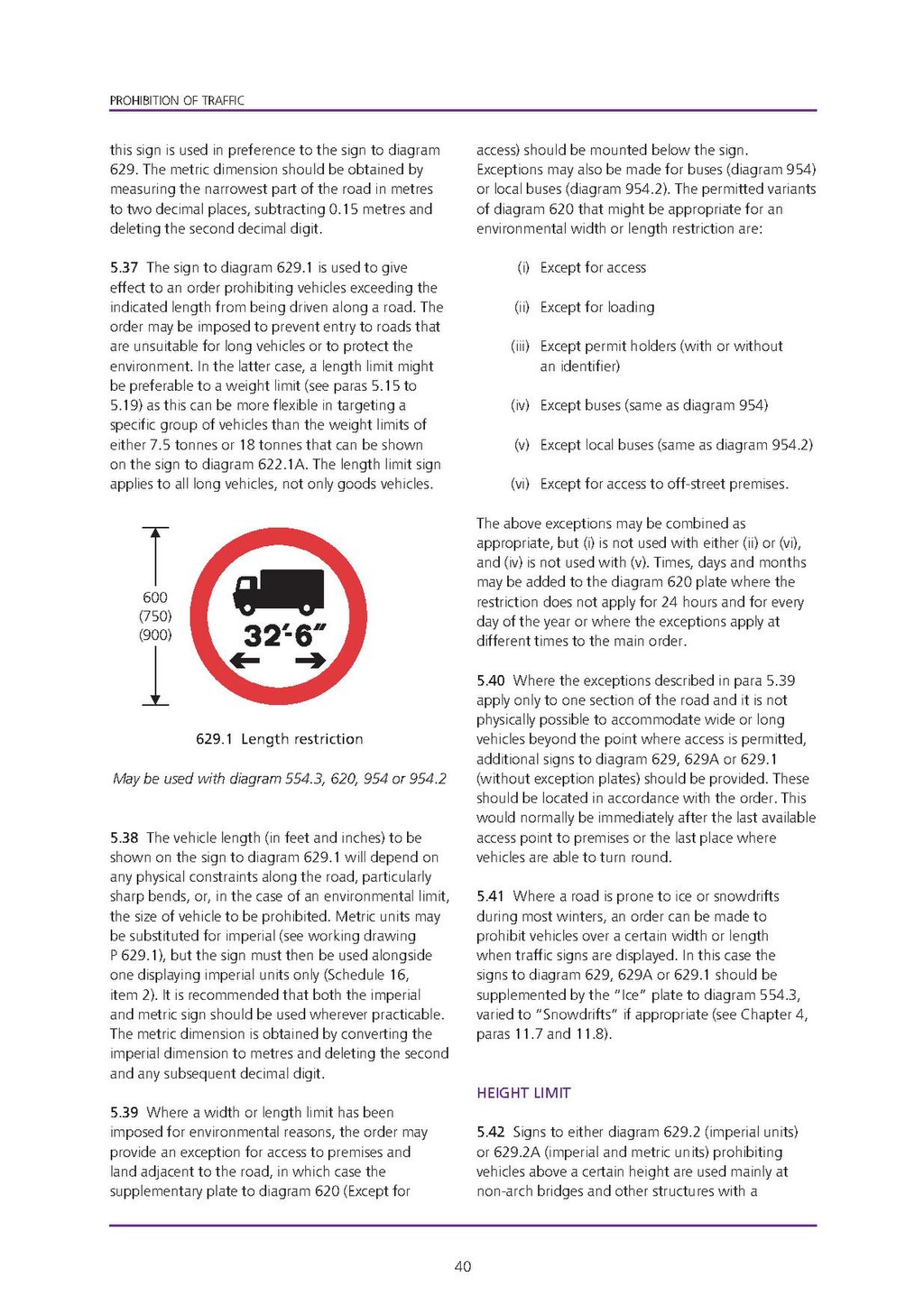this sign is used in preference to the sign to diagram 629. The metric dimension should be obtained by measuring the narrowest part of the road in metres to two decimal places, subtracting 0.15 metres and deleting the second decimal digit.
5.37 The sign to diagram 629.1 is used to give effect to an order prohibiting vehicles exceeding the indicated length from being driven along a road. The order may be imposed to prevent entry to roads that are unsuitable for long vehicles or to protect the environment. In the latter case, a length limit might be preferable to a weight limit (see paras 5.15 to 5.19) as this can be more flexible in targeting a specific group of vehicles than the weight limits of either 7.5 tonnes or 18 tonnes that can be shown on the sign to diagram 622.1A. The length limit sign applies to all long vehicles, not only goods vehicles.
5.38 The vehicle length (in feet and inches) to be shown on the sign to diagram 629.1 will depend on any physical constraints along the road, particularly sharp bends, or, in the case of an environmental limit, the size of vehicle to be prohibited. Metric units may be substituted for imperial (see working drawing P 629.1), but the sign must then be used alongside one displaying imperial units only (Schedule 16, item 2). It is recommended that both the imperial and metric sign should be used wherever practicable. The metric dimension is obtained by converting the imperial dimension to metres and deleting the second and any subsequent decimal digit.
5.39 Where a width or length limit has been imposed for environmental reasons, the order may provide an exception for access to premises and land adjacent to the road, in which case the supplementary plate to diagram 620 (Except for access) should be mounted below the sign. Exceptions may also be made for buses (diagram 954) or local buses (diagram 954.2). The permitted variants of diagram 620 that might be appropriate for an environmental width or length restriction are:
(i) Except for access
(ii) Except for loading
(iii) Except permit holders (with or without an identifier)
(iv)Except buses (same as diagram 954)
(v)Except local buses (same as diagram 954.2)
(vi) Except for access to off—street premises.
The above exceptions may be combined as appropriate, but (i) is not used with either (ii) or (vi), and (iv) is not used with (v). Times, days and months may be added to the diagram 620 plate where the restriction does not apply for 24 hours and for every day of the year or where the exceptions apply at different times to the main order.
5.40 Where the exceptions described in para #5.39 apply only to one section of the road and it is not physically possible to accommodate wide or long vehicles beyond the point where access is permitted, additional signs to diagram 629, 629A or 629.1 (without exception plates) should be provided. These should be located in accordance with the order. This would normally be immediately after the last available access point to premises or the last place where vehicles are able to turn round.
5.41 Where a road is prone to ice or snowdrifts during most winters, an order can be made to prohibit vehicles over a certain width or length when traffic signs are displayed. In this case the signs to diagram 629, 629A or 629.1 should be supplemented by the "Ice" plate to diagram 554.3, varied to "Snowdrifts" if appropriate (see Chapter 4, paras 11.7 and 11.8).
HEIGHT LIMIT
5.42 Signs to either diagram 629.2 (imperial units) or 629.2A (imperial and metric units) prohibiting vehicles above a certain height are used mainly at non—arch bridges and other structures with a
40

